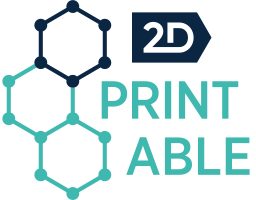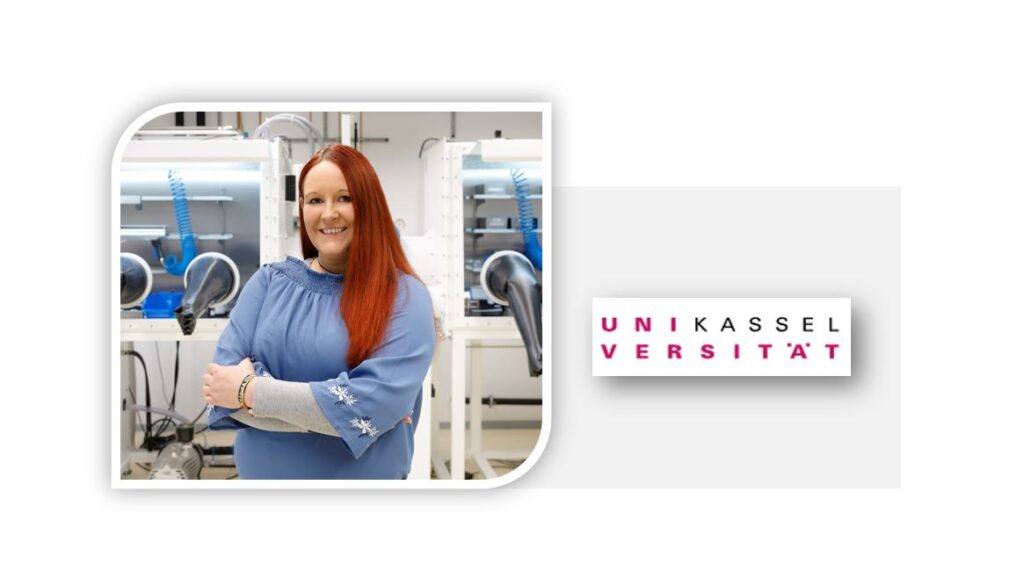My name is Claudia Backes and I am the youngest PI in the 2D-PRINTABLE project. I am a chemist by training, always devoted to physical chemistry and spectroscopy since I very much enjoy data evaluation and like to design experimental protocols to answer specific scientific questions. After my PhD with Andreas Hirsch in Erlangen and my postdoc with Jonathan Coleman in Dublin, I started an independent Junior research group in Heidelberg associated with the Chair of Applied Physical Chemistry headed by Jana Zaumseil. There, I was able to establish my independent research which is very much at the interface between chemistry and physics, but also involving aspects of engineering and processing. In 2022, I was appointed Chair professor at Kassel university. In 2D-PRINTABLE, we do a bit of everything that is related to production of inks containing platelets with controlled size and thickness, functionalization and pushing the current boundaries of characterization.
What was your original motivation to become a researcher
To be honest, I had originally not planned to become a researcher. When it came to the decision of doing a PhD or not, I was given the opportunity to work with carbon nanotubes which I found a fascinating material. During that time, I fell in love with science and it all went from there. I didn’t think I’d be good enough to become a professor, but thanks to very supporting people in my environment, I gave it a go.
What is your (main) research area today?
Our current research relies on crushing down macroscopic rocks in suitable liquids to produce inks of nanomaterials, typically platelets in a process termed liquid exfoliation. We place particular emphasis on understanding details of the production mechanism and further processing, for example size selection through centrifugation. This allows us to make nanomaterials with relatively well-defined sizes, ideal to investigate size dependent (linear optical) properties or understand further chemical modification. Here, we design new characterization protocols based on widely available techniques to understand the material’s reactivity.
What is the main objective of your team in 2D-PRINTABLE?
“Within 2D-PRINTABLE, we apply our knowledge on nanosheet production and characterization to new materials on the one hand and aim to further optimize the production on the other hand in a back-loop. Further, we will use our understanding of the reactivity of model substances and exploit it to for example achieve nanosheet cross-linking in networks to improve charge transport or to achieve chemical doping.”
What expertise and facilities does your team have to meet those objectives?
“I am really excited to be a PI in 2D-PRINTABLE, since it aligns extremely well with our overall research direction. In my labs, we have facilities for the ink production and processing, including a range of suitable centrifuges and different means of producing the platelets, also under inert gas conditions for water and oxygen sensitive materials (sonication, shear exfoliation, electrochemical, chemical). We have access to a range of spectroscopy and microscopy for further characterization. Most relevant for 2D-PRINTABLE are two new toys in my group: diffuse reflectance infrared Fourier transform (DRIFT) spectroscopy and thermogravimetric analysis coupled to gas chromatography and mass spectrometry (TGA-GC-MS) which will help us understand the functionalization to a much deeper level and where we currently do the methodological development to make full use of these two complementary techniques.”
Which aspects of your research at 2D-PRINTABLE do you believe are the most innovative and what unique opportunities offer 2D-PRINTABLE to yourself and/or your organisation?
What I like most about 2D-PRINTABLE is that it combines unique expertise from all partners to understand all details of the process chain from material identification, production, processing and functionalization to the device. This is really fantastic, as it will enable knowledge-driven progress in devices. For me, it is an amazing opportunity since we are mostly working on fundamentals of exfoliation, functionalization and characterization and it is really exciting to be in a consortium with more application-oriented groups which allows a swift application of new fundamental insights and translate those to applications.
How do you see the future use of the 2D-PRINTABLE results and the impact of 2D-PRINTABLE project in our daily lives?
The beauty of the approach of 2D-PRINTABLE clearly is the versatility and broad applicability to a range of materials and material classes. As such, the results will have an impact in diverse areas related to wearable and stretchable electronics and coatings from health monitoring to energy saving lighting, smart windows or novel solutions for green energy conversion.


